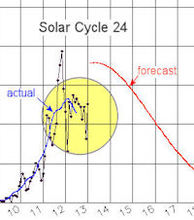"This is solar maximum," he suggests. "But it looks different from what we expected because it is double peaked."
Reality, however, is more complicated. Astronomers have been counting sunspots for centuries, and they have seen that the solar cycle is not perfectly regular. For one thing, the back-and-forth swing in sunspot counts can take anywhere from 10 to 13 years to complete; also, the amplitude of the cycle varies. Some solar maxima are very weak, others very strong.
Pesnell notes yet another complication: "The last two solar maxima, around 1989 and 2001, had not one but two peaks." Solar activity went up, dipped, then resumed, performing a mini-cycle that lasted about two years.
The same thing could be happening now. Sunspot counts jumped in 2011, dipped in 2012, and Pesnell expects them to rebound again in 2013: "I am comfortable in saying that another peak will happen in 2013 and possibly last into 2014," he predicts.
Another curiosity of the solar cycle is that the sun's hemispheres do not always peak at the same time. In the current cycle, the south has been lagging behind the north. The second peak, if it occurs, will likely feature the southern hemisphere playing catch-up, with a surge in activity south of the sun's equator.
| "The Solar Cycle 24 Prediction Panel has reached a consensus. The panel has decided that the next solar cycle (Cycle 24) will be below average in intensity, with a maximum sunspot number of 90. Given the date of solar minimum and the predicted maximum intensity, solar maximum is now expected to occur in May 2013. Note, this is not a unanimous decision, but a supermajority of the panel did agree." Read the rest of the story at: http://science.nasa.gov/science-news/science-at-nasa/2013/01mar_twinpeaks/ |

 RSS Feed
RSS Feed